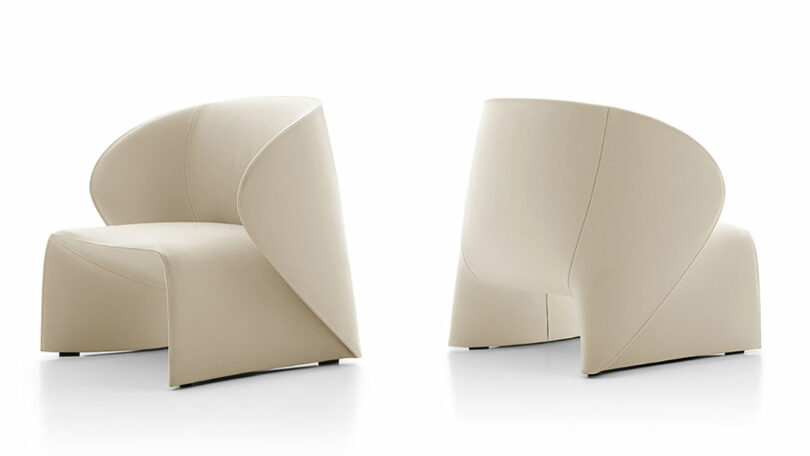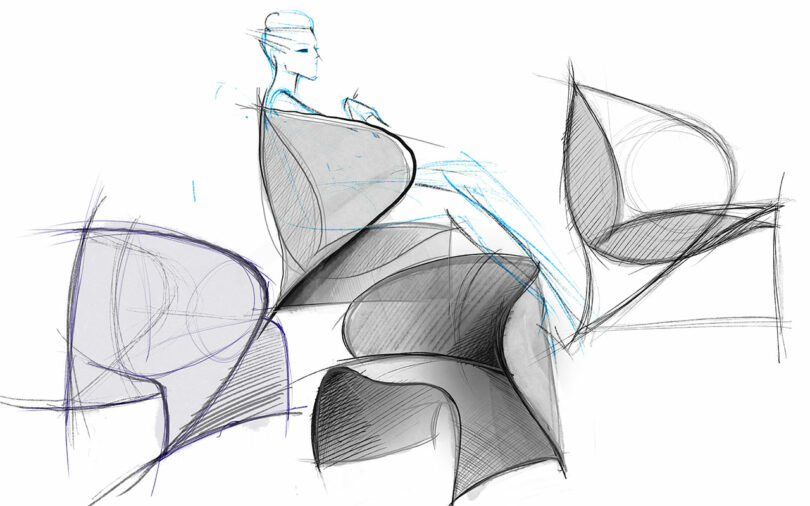
[ad_1]
With only one crease, a smooth textile surface folds back over itself for a layered effect juxtaposing round edges against those that are rectilinear. Akin to bespoke garment construction, the Narinari chair – designed by Tiziano Guardini and Luigi Ciuffreda of Guardini Ciuffreda Studio for B&B Italia – is reminiscent of the double rounded French cuff creating what can only be described as a sartorial, sensory experience. Its origami-like folds create a seat as the surfaces imply volume gently cradling negative space with a welcome embrace. The sensuality of the armchair’s upholstered form is derived from an attention to detail echoing that of haute couture, tempered by its modest material palette.

Photo: Gionata Xerra
The nuanced design can be credited back to the duo’s decorated résumés: Guardini, with experience as a fashion designer, and Ciuffreda, a multi hyphenate who has collaborated with various architecture and design studios. The two share a history that began in 2019 where a passionate discussion revealed a shared aesthetic language comprising sinuous forms, tactile fabrics, and saturated hues. Since then, they have founded their multidisciplinary studio engaging in exhibition design, interior architecture, and textile science guided by the tenets of circularity and sustainability.

And this opportunity to collaborate with B&B Italia commemorates their first foray into home furnishings. The designers found alignment and support from the brand’s production managers, particularly Ambrogio Spotti, and Art Director, Piero Lissoni, who shepherded the concept through realization. The company prides itself on cross-pollination as it applies to the design process and their investment in young designers.

Among other things, the greatest inspiration for the armchair comes from the Aetobatus Narinari, the spotted eagle ray, a simple sea creature capable of gliding through the ocean depths and breaking the surface to catch some air with elegant ease. “… A majestic ballet between two worlds. This duality, this ability to live and master two such different elements, captivated and guided us in designing the armchair,” the creatives say. “The Narinari armchair reflects these qualities, combining strength and delicacy in a single enveloping form.”

Sitting in the armchair is characterized as an experience of welcome enhanced by a feeling of protection. Its perfect proportions and well-calibrated dimensions allow those seated a variety of positions in its concavities.

Where time has a tendency to conspire against fashion design, furniture making gave Tiziano space to delve even deeper into every fold of the chair. “Working on the prototype was exhilarating, much like adjusting the shapes of a garment on a mannequin,” he says. “It involved meticulous work on the curves’ connections, the form’s fit, the design of cuts and seams, and attention to details, such as the concealed zipper that makes the armchair’s cover removable.”

The team realized their vision for a dramatic chair whose material is pure, authentic, and capable of articulating the sculptural shape. With its consistency and softness, the 100% raw cut wool felt allows for the desired poetic narrative and an enhanced sensory experience. In addition, its composition allows for easy repair and re-entry into the regeneration process.

Guardini and Ciuffreda pored over works from art and design pioneers Gaetano Pesce, Yohji Yamamoto, and Robert Morris to study the varied applications of felt and its material implication. But perhaps their greatest achievement is adding to the expressive medium’s storied history.


Sketch by Tiziano Guardini and Luigi Ciuffreda

Tiziano Guardini and Luigi Ciuffreda
To learn more about the Narinari chair, visit bebitalia.com, or to find out more about the design duo, visit guardiniciuffreda2.cargo.site.

With professional degrees in architecture and journalism, Joseph has a desire to make living beautifully accessible. His work seeks to enrich the lives of others with visual communication and storytelling through design. Previously a regular contributor to titles under the SANDOW Design Group, including Luxe and Metropolis, Joseph now serves the Design Milk team as their Managing Editor. When not practicing, he teaches visual communication, theory, and design. The New York-based writer has also contributed to exhibitions hosted by the AIA New York’s Center for Architecture and Architectural Digest, and recently published essays and collage illustrations with Proseterity, a literary publication.
[ad_2]